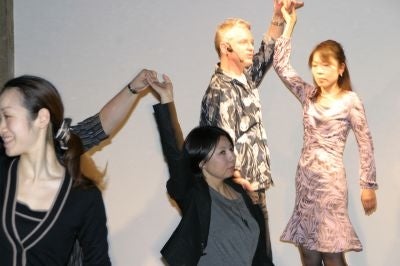Your support helps us to tell the story
From reproductive rights to climate change to Big Tech, The Independent is on the ground when the story is developing. Whether it's investigating the financials of Elon Musk's pro-Trump PAC or producing our latest documentary, 'The A Word', which shines a light on the American women fighting for reproductive rights, we know how important it is to parse out the facts from the messaging.
At such a critical moment in US history, we need reporters on the ground. Your donation allows us to keep sending journalists to speak to both sides of the story.
The Independent is trusted by Americans across the entire political spectrum. And unlike many other quality news outlets, we choose not to lock Americans out of our reporting and analysis with paywalls. We believe quality journalism should be available to everyone, paid for by those who can afford it.
Your support makes all the difference.Modern jive, the dance sensation that emerged from Britain, has arrived in Japan, bringing together elements of salsa, swing and ballroom, such as tango and jive, all set to a wide range of modern music.
The first ever Jive Motion event in Japan was held recently at Superdeluxe in Roppongi, with around 60 people - both Japanese and expats - attending the initial session to perform a mixture of modern jive moves.
Justin Hollingworth believes that the movement will catch on in Japan just as it has across the world after first appearing in Britain in the early 1980s.
"Modern jive has become a huge dance phenomenon in the UK, Australia, New Zealand and other places where Brits have settled, such as Southern Spain, Singapore and Hong Kong," said 46-year-old Hollingworth, who is originally from North London and first came to Japan in 1989.
"My ambition is to bring this movement to Japan and when people think of modern jive, I want them to think of Jive Motion," he said.
Jive Motion classes teach the 20 core, beginner moves before those who feel confident enough can move on to more technically difficult versions. At each session, dancers usually practice four of the basic moves, meaning that after just five or six sessions anyone will have mastered the beginner moves.
"The beauty of it is that anyone can do it, whether you're 16 or 66," he said.
"There are three basic reasons why so many people - many of whom were not previously dancers - are attracted," he said. "Firstly, you can dance to any music that has a four-four beat; secondly, it's very easy because there is no complicated footwork.
"That means you can make progress very quickly and look good soon after starting to learn," he said. "Compare that to ballroom dancing, where it will probably take a year for a couple to get one song looking good.
"And thirdly, modern jive is very accessible as you can just turn up without any special clothes or shoes," he added. "And because everyone changes partners throughout the evening, learning with a variety of dancers, you make progress much quicker."
Hollingworth first started dancing during a spell back in London in 2000, where the biggest name in the modern jive revolution is Ceroc, which holds events for around 50,000 people at dozens of venues across Britain every week.
"A lot of foreigners here know what this is about, but most Japanese don't know about pair dancing or modern jive," Hollingworth said. "I want this to become more mainstream in Japanese society rather than mostly for the expat crowd and we're starting in Tokyo but I want to get out to all the major cities across the country in the future."
For more information: http://www.jivemotion.jp
JR

Join our commenting forum
Join thought-provoking conversations, follow other Independent readers and see their replies
Comments